Except as noted, article and photos by Joe Mish
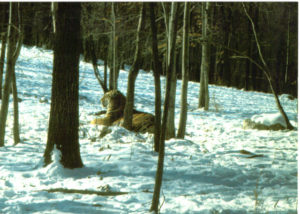
A Siberian tiger, out of place in modern times in New Jersey, comfortably rests on the frozen snow in sub zero temperatures, intensified by a strong northwest wind. Conditions that would turn exposed flesh beet red in an instant, didn’t phase this big cat as it appeared oblivious to the deadly weather; as if not bound by the laws of Nature.
It was a bitter cold day as Bert and I drove the Warner Bros Jungle Habitat trails to check on the open ranging wildlife that occupied the windswept mountains and valleys of the northern New Jersey wildlife park. Inside the warm Chevrolet truck, converted into a veterinary mobile unit, the heater was turned up high, while warm coffee steamed the windshield. Most animals escaped the polar wind hiding behind natural windbreaks and temporary shelters placed around the park.
As we drove past the tiger compound, near the highest point of the park, here was this tiger, a cat we affectionately named, ‘Bobtail’, lying down exposed to the full force of the wind. Bearing an ever present grin, for which the big cats are known, Bobtail appeared content, oblivious to the deadly arctic blast. He remained motionless and stared into the brutal wind that must have escaped from the 10th circle of Dante’s frozen hell, showing no signs of discomfort. He may as well have been enjoying a cool breeze on a warm summer’s day.
This image of Bobtail lying in the snow captures for me the essence of the tiger. Well documented accounts of tigers hunting humans in India, and their magical ability to make kill after kill and avoid inescapable traps, have elevated the tiger to supernatural status.
This is an animal believed to exist in the spirit world as a cunning killer with the ability to transform into flesh and bone and back again at will. The tiger has a reputation of defying natural law that limits all other living things; Bobtail was doing nothing to dispel that myth on this cold day.
The poem, “Tyger”, by William Blake, written in 1794, so well captures the visceral reaction I had to the tigers, I memorized the poem. Here are a few lines that chill my blood.
In what distant deeps or skies Burnt the fire of thine eyes?
And what shoulder, & what art. Could twist the sinews of thy heart?
While here is photographic proof of a tiger living in New Jersey, an anomaly for sure, it is not hard to imagine a time when big cats stalked our land. I wondered every time I passed the tiger compound, how humans ever survived these Paleolithic predators. Perhaps it was the predators’ evolved intelligence that raised the level of human creativity in a Darwinian dance played to a deadly tune.
Evidence of saber tooth cats and jaguars, among other prehistoric creatures, were found in a limestone cave in southeastern PA near Pottstown and trace back to the cretaceous period about 100 to 66 million years ago. The cave was located in a now forgotten town named Port Kennedy, which is part of Valley Forge National Park.
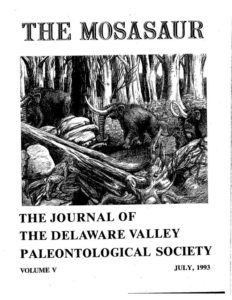
Evidence of sabre-tooth cats of the late cretaceous period discussed in this 1993 article. Additionally fossil remains have been found in the Cutter Clay works near Raritan Bay and along the shore across Raritan Bay in Union Beach.
NJ was unrecognizable in terms of geography and climate with glaciers terminating at the Watchung Mountains and our rivers not yet formed. The Hudson River at one time was thought to have emptied into the lower Raritan watershed at Bound Brook.
As the sea level rose and fell over the eons, it formed clay banks along the Raritan and its bay where dinosaur fossils and tracks have been found. To date, I am not aware of any prehistoric cat trackways or fossils being discovered in NJ. Though surely, when southern NJ was above water, it would be reasonable to expect prehistoric cats, whose remains were found in the Port Kennedy Cave, to have roamed our land.
In more modern times the eastern mountain lion did stalk the shores of the Raritan and in fact a bounty was offered and the last local cat killed in the Sourland Mountains in the early 19th century. Officially, the last New Jersey mountain lions were killed in the southern most counties about that same time.
Rumors of mountain lions persist in several north east states, though no hard evidence has been uncovered in NJ. Given the fact that people have been known to illegally harbor large cats in less than secure enclosures, anything is possible.
Today, New Jersey has a healthy population of bobcats, primarily in the northwest part of the state. The retreating glaciers left a boulder strewn, mountainous landscape with plenty of nooks and crannies, ideal habitat for these elusive felines. Occasionally bobcats are captured on hunters’ trail cameras to give us evidence of their presence as they are rarely ever seen even where they are plentiful.
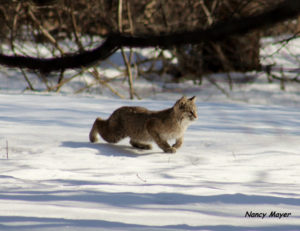
This very rare photo of a bobcat was taken in Warren County, NJ. New Jersey has a healthy bobcat population along with other wildlife thought not to exist within our borders. This cat is really a sabre-tooth tiger distilled down to miniature with all the accumulated intelligence and instincts required for survival in any geologic iteration of New Jersey. Photo by Nancy Mayer
Still the thought of saber-tooth cats, tigers and jaguars ranging across the state becomes more than just imaginary when you see the gleam in your pet cat’s eye. It is as if the prehistoric felines have been distilled down to their essence in the form of modern day cats that dominate many of our homes.
“The Man-Eaters of Kumaon”, by Col Jim Corbett, published in 1944, deals with the man eating tigers of India in the early 20th century. Please read the last chapter, “Just Tigers” before you begin the book as it puts the tiger in perspective and talks about photography vs hunting and concern for their the conservation even at that time. The first hand account of the almost supernatural ability of tigers to avoid being killed or captured while hunting humans, reveals an intellectual battle where man doesn’t always dominate nature.
THE TYGER
By William Blake
Tyger! Tyger! burning bright In the forests of the night, What immortal hand or eye Could frame thy fearful symmetry?
In what distant deeps or skies Burnt the fire of thine eyes? On what wings dare he aspire? What the hand dare sieze the fire?
And what shoulder, & what art. Could twist the sinews of thy heart? And when thy heart began to beat, What dread hand? & what dread feet?
What the hammer? what the chain? In what furnace was thy brain? What the anvil? what dread grasp Dare its deadly terrors clasp?
When the stars threw down their spears, And watered heaven with their tears, Did he smile his work to see? Did he who made the Lamb make thee?
Tyger! Tyger! burning bright In the forests of the night, What immortal hand or eye Dare frame thy fearful symmetry?
1794
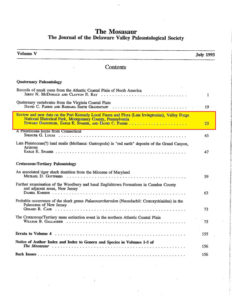
Author Joe Mish has been running wild in New Jersey since childhood when he found ways to escape his mother’s watchful eyes. He continues to trek the swamps, rivers and thickets seeking to share, with the residents and visitors, all of the state’s natural beauty hidden within full view. To read more of his writing and view more of his gorgeous photographs visit Winter Bear Rising, his wordpress blog. Joe’s series “Nature on the Raritan, Hidden in Plain View” runs monthly as part of the LRWP “Voices of the Watershed” series. Writing and photos used with permission from the author.
Article and photos by Joe Mish
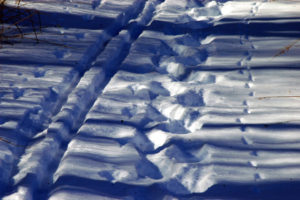
The hiker skier and the fox
passed this way on a snowy walk
The same path was taken on that day
Though each saw things a different way
Dawn was hardly accomplished when the charcoal sky, stirred by a strong cold wind, began to hurl sharp ice crystals against the dry fallen leaves. The High velocity ice pellets struck the forest floor to reverberate against the dry leaves and create a mesmerizing steady hum.
The expansive old woods, now under siege by the late November weather, had a logging road cut through it sometime in the past that now resembled a linear scar threading through the trees. The thick canopy of branches blocked the sunlight to prevent the cut from healing and provided an unobstructed view and silent pathway, for at least a hundred yards. Any bird or animal travelling across the woodlot could be easily seen.
From my vantage point, where the road curved around a large boulder to the straightaway before me, I paused to take in the view. The falling ice began to accumulate; it was like watching an invisible hand weave a white rug on a rough umber tinted latticework. The ice would take turns with large snowflakes as this tandem team laid down white pavement on the road. The thick canopy of branches in the surrounding woods prevented much of the falling snow from reaching the ground. The white flakes and ice crystals that fell here resembled a light scattering of powdered sugar that stood in stark contrast to the near solid white woods road.
The woods are transformed with a light snow as hidden pathways and game trails show up as white lines and the thick woods instantly fitted with clear windows into the woodland depths. Any animal previously hidden by the labyrinth of branches in the one dimensional muted background of similar color, now are exposed as dark forms against white as they pass through these previously invisible portals. The slightest movement, even at a distance, now betrays an animal’s presence as sound becomes an irrelevant turncoat.
Feeling chilled, I was about to resume my walk when a quick movement in the woods caught my eye. Like watching a silent movie in black and white, a woodland drama was about to unfold.
Some small, fast animal was running along the ground in a straight line, on a course that would take it across the woody lane. In short order it appeared in the open and I was still questioning its identity. I could now see this was clearly a bird as it looked like a pigeon, though slightly larger. It was so odd to see a bird running instead of flying and given its speed, its health did not seem compromised. The fleet footed bird was a ruffed grouse! I recalled seeing grouse feeding in the predawn light on other occasions and thinking how they resembled pigeons.
In less than 15 seconds, another larger form appeared and was clearly running along the same track as the grouse. This was a red fox!
The fox had probably gotten a glimpse of the grouse, lost sight of the bird, then picked up its scent to begin the chase. The grouse felt confident enough it could escape on the ground as the fox was in steady but lagging pursuit.
The bird would take to the air if the fox came within striking distance and barring intervention from a hungry cooper’s hawk, the grouse would enjoy the rest of the day in peace. The fox was on a foolish pursuit chasing an alert grouse. Its hunger in full argument with its experience arrived at a compromise and the chase began in deference to hunger.
I waited another few minutes and couldn’t resist trying to call the fox in. Like magic the fox came running, sat at the edge of the lane in the white snow and stared in my direction for a good minute, stood up and trotted off.
As the fox disappeared in the distant woods I again began to walk down the canopied lane enjoying the snowy woods.
The old logging road weaving through the trees scattered with snow brought the lines from poet Robert Frost to life. From “A road not taken”:
“… and looked down one (road) as far as I could, to where it bent into the overgrowth”.
Then the line from Stopping by the woods on a snowy evening:
“…to watch his woods fill with snow”……
“The only other sound’s the sweep
Of easy wind and downy flake.”
Unwrap the gift of a light November snow and enjoy sights and sounds that have inspired the verse of American Poets.
Author Joe Mish has been running wild in New Jersey since childhood when he found ways to escape his mother’s watchful eyes. He continues to trek the swamps, rivers and thickets seeking to share, with the residents and visitors, all of the state’s natural beauty hidden within full view. To read more of his writing and view more of his gorgeous photographs visit Winter Bear Rising, his wordpress blog. Joe’s series “Nature on the Raritan, Hidden in Plain View” runs monthly as part of the LRWP “Voices of the Watershed” series. Writing and photos used with permission from the author.
Article and photos by Joe Mish
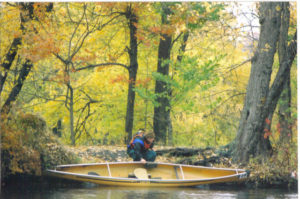
A yellow, curled up autumn leaf or a Kevlar canoe, both are more than capable of transporting a traveler and their imagination through the autumn scenery along the South Branch of the Raritan and reveal a glimpse of the hidden, natural world.
The early morning October sun shown through the amber hull of my Kevlar canoe to resemble a bright yellow leaf with curled up edges that fell gently upon the water’s surface. It is easy to imagine sitting in that curled leaf, high and dry, while riding the river’s swirling currents. Witness the secret world of nature that shies away from sound and movement as you silently drift downstream. The leaf provides a cloak of near invisibility as you now become a spirit on a journey through the physical world.
I set my Kevlar leaf upon the water and settled in to the sliding bucket seat with my hips and knees braced against the gunnels and held in place by the foot brace. I was now an integral part of the canoe, my slightest movement instantly transmitted to the hull. A single paddle stroke turned the bow into the current which magically spun the boat and took it downstream. A draw stroke and a shift in weight against the hull and was enough to direct my yellow leaf on a journey thru the October scenery along the South Branch.
This morning, the brilliance of autumn foliage was muted by a fine mist rising from the river. Shafts of sunlight, however, gave a preview of the colors soon to be unveiled as the mist gave way to the bright, clear fall day.
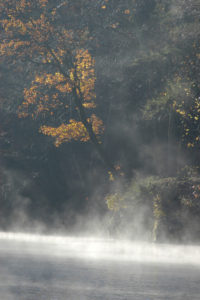
I soon spotted a pair of wood ducks nervously swimming in circles in an eddy downstream of a fallen tree. To get as near as possible for a photo, I kept the paddle in the water opposite the side of the ducks and used a figure eight movement to propel and steer the boat into position for the best camera angle.

The boat drifted quite close before the pair of woodies flew off; when disturbed, they make an unmistakable, repetitive, two tone alarm call. The fast action framed by autumn color and blue sky, was over in seconds as the echo of their calls faded in the distance.
What remained was an indelible image of these little birds gaining flight so quickly and flying full speed between the drape of overhanging branches, covered with orange leaves, and the calm reflective water of the eddy.
Though a diminutive bird, the full range of motion of its wings barely cleared the passage between the trees and water. The tip of the longest flight feather, almost imperceptibly, left marble sized imperfections in the mirrored surface with each wingbeat as the birds disappeared in the distance around the curved riverbank.
The river then straightened out to provide a wide angle perspective spreading out before me. The trees on either bank were ablaze in yellow, orange, red and scarlet, the color intensified by the position of the sun and a near cloudless sky of the brightest sky blue you can imagine. A rare white fluffy cloud, low on the horizon, stood in stark contrast against the celestial blue concentrate. To behold such a bucolic scene while riding on a magic carpet suspended on a river of energy within a kaleidoscope of color, mind and body enjoy a brief respite from thought, time and place.
Several more miles downstream, my curled yellow leaf followed a deep channel along the high, red shale riverbank that gently curved to the left. The water, here, expressed deliberate intent as its energy flowed fast, allowing me to remain almost motionless. The hydraulic backwash on either side of the narrow channel kept the boat centered with minimal intervention from my paddle.

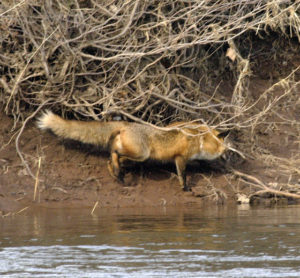
Ahead, a red fox walked along the steep bank at the water’s edge, apparently preoccupied with maintaining its footing. The angle of my approach and wind direction helped cover my scent and sound, allowing the fox to remain undisturbed. When I felt the fox’s field of vision was momentarily diverted, I would make a forceful paddle stroke to close the distance. Unbelievably, I was able to drift up behind and to the right of the distracted fox. After several photos the fox realized it was exposed and tried to escape up and over the vertical bank. In its haste, the fox slipped and almost fell into the river. Momentarily stunned by the unexpected action and the current’s demand for immediate attention, the fox’s embarrassing moment was safe from digital publication.
As a passenger on an imaginary floating autumn leaf, carried along by the energy of moving water, the next stop could be anywhere in the world where the sweet water of the South Branch flows. I chose, however, to get off in an overgrown pasture resplendent in autumn color, my yellow leaf turning back into a Kevlar canoe and a quarter mile uphill portage for which I had to supply the energy.
Author Joe Mish has been running wild in New Jersey since childhood when he found ways to escape his mother’s watchful eyes. He continues to trek the swamps, rivers and thickets seeking to share, with the residents and visitors, all of the state’s natural beauty hidden within full view. To read more of his writing and view more of his gorgeous photographs visit Winter Bear Rising, his wordpress blog. Joe’s series “Nature on the Raritan, Hidden in Plain View” runs monthly as part of the LRWP “Voices of the Watershed” series. Writing and photos used with permission from the author.
Article and photos by Joe Mish
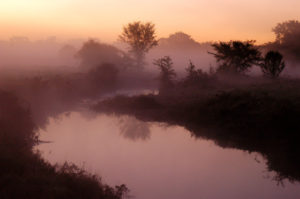
The dawn of the first day of September turns a mundane view of Holland Brook into a scene of stunning beauty that vanishes in the light of day
September arrives with the gentleness of the March lamb, whose fleece is tinged with shades of orange, scarlet and yellow. This month is shepherded in by a genial sprite whose name is associated with autumn, even though 21 days out of 30, are owned by summer.
The dominant green of summer foliage and grass is now the canvas upon which colors begin to appear. The classic autumnal portraiture is prompted by the choreographed movement of the planets which direct changes of light and temperature on earth.
September imperceptibly, at first, applies a touch of persimmon to leaves of the black gum tree, found in moist upland areas of the upper Raritan watershed. That shade of orange stands out boldly against the mass of green. Its elongated leaf, larger at the base, tapering to a rounded tip, suggests a festive light, reminiscent of an old fashioned Christmas tree light bulb.
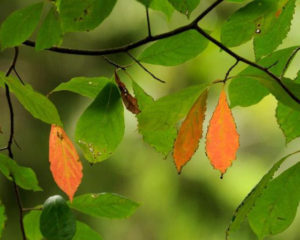
Perhaps using a fine squirrel tail paint brush, and confident from the first strokes of subdued orange, deep scarlet begins to appear on trees as the subtle necklaces of green Virginia creeper vines now glow a brilliant red. The necklace is the first adornment applied, before dressing in the full compliment of matching fall color later in October.
Happy with its brush stokes and color selection, September lingers in the red spectrum to color poison ivy at the base of trees to appear as a ground hugging extension of the soon to be, colorful tree tops. The poison ivy is also used to decorate unsightly stumps and dead limbs close to the ground to clean up the scene with a colorful red and orange cover cloth.
Imbued with the freedom of a bohemian artist, buoyed by success, the compound leaves and fruit of the staghorn sumac, is chosen as a progressively bold, next move. The deepest reds are mixed to produce a flat, dark maroon to saturate the trees large, upright velvety seed cones. Another blend of scarlet and bright red is mixed and applied to the long compound leafs which so easily wave in the slightest summer breeze and glow in the low sunlight when covered with early morning dew.
Taking a step back to view the perspective of its green canvas scattered with specks of color, September wants to jump ahead and fulfill October’s contract and apply full color to the landscape.
The planets and stars, however, have strict rules by which months must abide. Not to be discouraged, September discovered a way to express its soul in full color and still be true to the rules of nature.
While temperature, atmosphere and light invisibly impact the color of leaves, their physical nature allows these invisible conductors to be seen in full color in certain conditions. September would paint the atmosphere using temperature and light as its medium to transfer momentary color, making the entire landscape come alive!
The daily temperature difference that occurs during the summer to autumn seasonal transition produces heavy morning mists along waterways that is showcased in the arena of open meadows and flood plains.
Dawn along the South Branch in September can be very dramatic as the low morning sun shining thru clouds and dust particles produces constantly changing, breathtaking colors in the sky, water and lingering mists. The lighting and colors are so dramatic; the same scene is not recognizable in full daylight.
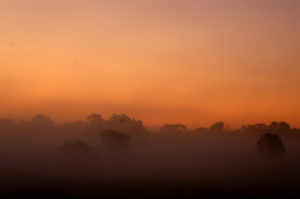
The ability to dabble in orange and red poison ivy and then produce an ever changing orange sky set upon a purple haze is nothing short of pure magic. Actually, it is all science, for the moment, however, magic best describes a September morning.
September was restrained from applying more color to static objects during its tenure but found a way to make God movie background scenes using the most brilliant colors of visible light, atmosphere and temperature.
Author Joe Mish has been running wild in New Jersey since childhood when he found ways to escape his mother’s watchful eyes. He continues to trek the swamps, rivers and thickets seeking to share, with the residents and visitors, all of the state’s natural beauty hidden within full view. To read more of his writing and view more of his gorgeous photographs visit Winter Bear Rising, his wordpress blog. Joe’s series “Nature on the Raritan, Hidden in Plain View” runs monthly as part of the LRWP “Voices of the Watershed” series. Writing and photos used with permission from the author.
Article and photos by Joe Mish
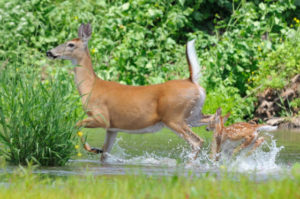
Doe and fawn kick up thie heels in the cool water of the South Branch of the Raritan.
Deer love to wade in the river, even at noon, on the hottest summer days
High Summer Drama
The low dam at Red Rock Lake turned the water of the South Branch inside out to create an unbroken white line along its length. Here, the living water falls upon itself in an act of resuscitation, no different from lifesaving CPR.
Below the dam, the freshly oxygenated water rushes to fill a deep cut in the river bed funneling its energy, impeded elsewhere by shallows and exposed tree roots.
At the start of each trip, below the lake, I do an upstream ferry across the fast water as a tribute to the river’s energy. I provide the proper angle and the river obliges with a free ride across the current with no downstream slip. Angle the bow into the opposing current and the boat spins into a downstream posture to start another river journey through the high summer season.
The water’s surface reflected the bright blue summer sky and lush greenery along the shoreline. The river banks falsely declaring a limit to the infinite reach of the sky.
August is indeed high summer, all plant life at full maturity vying for sunlight, slender and long, eager to dance in the gentle summer breeze.
Lush, light green grass hung over the river bank in one treeless stretch when I saw a painted water snake swimming to the opposite shore. Only the head of the snake, which created a small wake, betrayed its presence. As I neared, the snake slightly altered course. A few feet from the left shore it suddenly rose up, as if struggling. It would have had to press up against something to rise as high as it did and since the water was still quite deep, it begged investigation.
In an instant a snapping turtle’s head broke the surface of the water, draped in dark green grass and holding the snake near the end of its tail end. Such a non vital hold promised a long struggle and struggle the snake did. I began to record images of this fight for life, so inconsistent in such a peaceful setting.
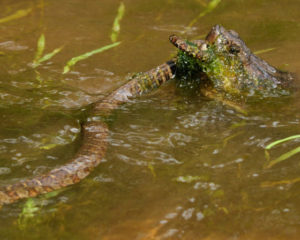
The surprise reptilian clash held the colorful snake in close contrast to the turtle’s head. The turtle’s mouth was more of a razor edged compact beak, a creamy tan with fine vertical black lines. The round orb of its bulging eye and dark pupil were the only recognizable shapes against a pattern of dull and dark brown irregular patches that covered the turtle’s head. The black pupil was surrounded by three thick, dark brown streaks radiating out at 3, 6 and 9 o’clock positions, a pattern quite like a style of crosshair seen in some rifle scopes.
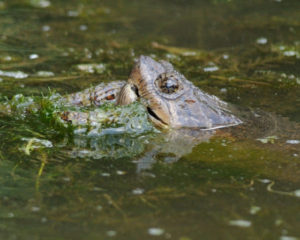
The painted water snake, alias, northern water snake, by its nature, was a linear billboard showcasing a recurring pattern of a variety of shades of tan and orange, and black, the pattern getting tighter and more compact near the tail. The snake must a have just shed, as its colors gleamed to a high shine, enhanced by the water.
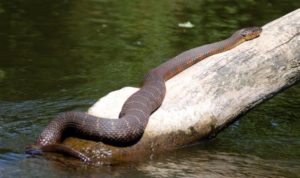
This is a painted/northern watersnake; the colors are more brilliant just after it sheds its skin.
This snake recently dined on some other good sized aquatic critter, now seen as the large bulge in the snake’s stomach.
The fight raged on for several minutes, coming to an abrupt end when my boat drifted closer to the combatants. The turtle became intimidated and released the snake, drama over, no evidence of what had just taken place except for some digital images. I imagine the education of both animals was advanced by their encounter.
A mile down river the scenery changed as the main current, hugging the up heaved, high, red shale cliff, was slowed by a gravelly shoal stretching across the river. Here, the high cliff disappeared back into the ground to give way to a woodsy landscape. The river narrowed and water became deeper. The tree tops reached across the river to give the impression of a leafy tunnel. This was a straight, short stretch that now opened up to allow the first river view of the Sourland Mountains. An island divided the river here, diverting more water to the right passage around a sharp bend, than to the left.
The island had a few small trees smothered in tall sun drenched, light colored grass that reached into the shallow water. Recent events had kept the water level far below normal and as a result, the delicate grass began to grow and prosper where it normally would not. The water level on this day was now raised and flooded the fine green grass.
Here, the river bed follows a deep, narrow cut, close to the right shore and obstructed with fallen trees. From the island to the cut, the river was impassably shallow. Coming around sharp bends on an intimate river usually holds the best surprises. Today was not a disappointment as a doe was standing in the water staring at me from 20 feet away.
There was little I could do keep still, as the narrow passage along the bank required some quick paddle strokes to avoid being grounded. That mandatory movement caused the doe to run off, seeming more annoyed than frightened. Behind her were two spotted fawns that splashed away through the shallow water and tender grass. The one fawn ran toward a second doe, keeping close to her heels. Alerted, the doe and fawn ran a few paces and stopped. They really were reluctant to end their mid day romp in the cool river. Water droplets flew in slow motion as the doe and fawn ran off two more times. The light green grass was finely detailed, while the same green scene reflected in the water, lost the detail, but kept the essence of the verdant color to make the foreground and background indistinguishable from each other. The two deer, resplendent in their red summer coats, the fawn, speckled white, complimented the green background.
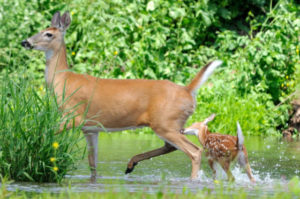
The water exploded from splashing hooves to energize the scene, as it stood in contrast to the reflective water. Raising her pure white tail, the doe provide an exclamation mark to the perfect image to represent high summer on the South Branch.
Author Joe Mish has been running wild in New Jersey since childhood when he found ways to escape his mother’s watchful eyes. He continues to trek the swamps, rivers and thickets seeking to share, with the residents and visitors, all of the state’s natural beauty hidden within full view. To read more of his writing and view more of his gorgeous photographs visit Winter Bear Rising, his wordpress blog. Joe’s series “Nature on the Raritan, Hidden in Plain View” runs monthly as part of the LRWP “Voices of the Watershed” series. Writing and photos used with permission from the author.
Article and photos by Joe Mish

This female red phase screech owl with erect ear tufts and large eyes looks as ferocious as it sometimes sounds.
The calm starlit night, made blacker by the dark phase of the moon, was the perfect setting for a peaceful night’s sleep. The windows were wide open and the air scented with honeysuckle as the gentle sounds of the night played a sleepy time lullaby.
Deep sleep and dreams were well under way when a primal scream, just outside the window, vibrated the walls. Everyone sat up, hearts beating wildly, sleeping coonhounds unleashing unheard of sounds that must have been reserved in the event they ever treed the devil.
Before my heart beat slowed, I figured the sounds had to come from a screech owl perched on a tree limb six feet from the bedroom window. The unearthly screams were one selection of screech owl vocalizations that include rapid clicking of its beak and a gentle wavering call that, through association with spooky movies can easily raise the hairs on the back of your neck.
The volume of a screech owls’ motivated scream is inconsistent with its small size. The eastern screech owl is about 9 inches tall, weighs around 6 ounces with a 24 inch wingspan and easily fits through a three inch nest box hole.
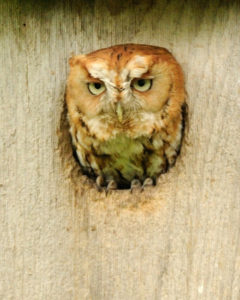
Adult red phase screech owl perches in 3″ hole of its nest box, note the feet gripping the edge of the opening.
Eastern screech owls come in two colors, a red phase and a gray phase. Its physical appearance, while perched, gives the impression it is missing the lower half of its body. During the day with its eyes shut it blends in so perfectly with its background it is difficult to tell what part is what. The owl seems to suddenly appear from the background when it opens its large yellow eyes.
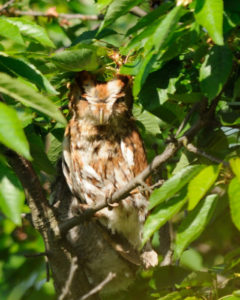
Eyes closed, these owls seems to disappear with no reference to top or bottom or recognizable form.
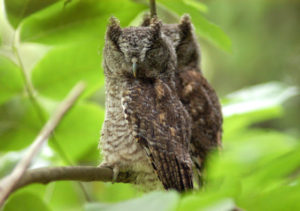
Screech owls seem to comfortably tolerate humans and can be seen, and will nest, in proximity to homes and buildings if a nest box is provided.
Late June early July, a screech owl would show up whenever I went into the backyard around dusk. It would follow me around and click its beak from a nearby branch. I have no idea what motivated that behavior but that owl provide plenty of photo opportunities.
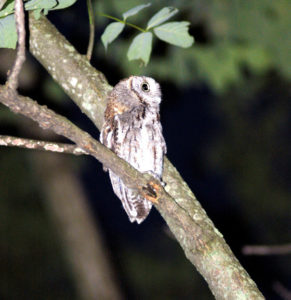
Then there were the memorable Christmas day visits. One Christmas morning I went to the open woodshed to replenish the woodstove with an armful of oak. There, staring me in the face from four feet away was a gray phase screech owl. It stayed put while I gathered the wood but was gone when I returned with my camera.
A few years later on Christmas night, a red phase screech owl perched a few feet off the ground in a weeping cherry tree. The little owl was spotted by the car’s headlights. It remained undisturbed while I did capture its image.
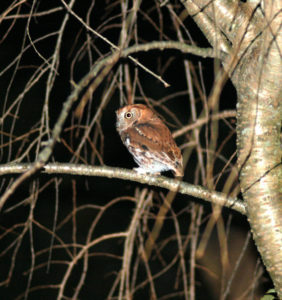
A late Christmas present in full feather, delivered at the front door.
Screech owls may just as well be found in deep woods. I have a great image of a red phase owl sitting in a healed hole in the side of a large tree trunk about eight feet off the ground. Other sightings have been in places where mature sycamore trees grow. Often, broken branches will leave a cavity that overtime becomes deeper, forming a perfect nest or day time resting place for this diminutive owl.
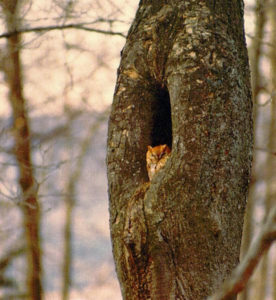
Though screech owls are quite common, you may never see one. Think of them as a night time radio host whose show you listen to all the time but never put a face to the voice. Hear a sampling of screech owl calls at: https://www.allaboutbirds.org/guide/Eastern_Screech-Owl/sounds
Author Joe Mish has been running wild in New Jersey since childhood when he found ways to escape his mother’s watchful eyes. He continues to trek the swamps, rivers and thickets seeking to share, with the residents and visitors, all of the state’s natural beauty hidden within full view. To read more of his writing and view more of his gorgeous photographs visit Winter Bear Rising, his wordpress blog. Joe’s series “Nature on the Raritan, Hidden in Plain View” runs monthly as part of the LRWP “Voices of the Watershed” series. Writing and photos used with permission from the author.
Article and photos by Joe Mish
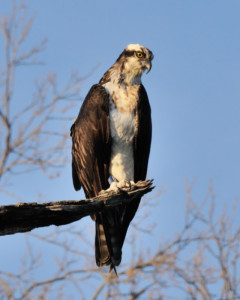
The osprey from Maine searches the clear water of the South Branch for a meal as she takes a break from her 2,500 mile journey north. The letters, DV, can be seen on the blue band attached to her right leg.
The warmth from the mid-morning sun felt good on my back as I paddled the low, clear water of the South Branch. The cloudless sky, directly above, was a darker shade of blue, its intensity pure and endless, and mesmerizing. It compelled me, as the devil’s advocate, to search for just a single speck to interrupt its perfection.
Suddenly a shadow sped across the water, momentarily stealing the sunlight. I instinctively looked up to catch a glimpse of an osprey circling above. The white head, streaked with a dark brown stripe, was instantly recognizable. The osprey proceeded downriver by making tight overlapping circles in its search for fish. It isn’t too hard to imagine some of these super intelligent predators realize a canoe is herding the fish ahead of it. When the osprey was about 150 yards downstream it tucked its wings and dove into foot deep water to come up with a large white sucker held fast in its black talons. The bird oriented the position of the fish to cut wind resistance as it flew out of sight.
Ospreys are ever present on the South Branch, typically from early spring to mid autumn. They feed primarily on live fish. I see them most often eating white suckers, a fish large enough to compensate for the energy spent to catch it.
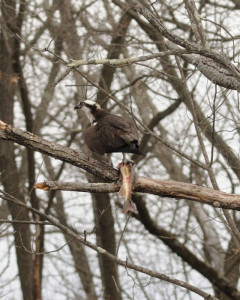
Osprey on a riverside perch, dining on fresh fish during the 2014 NJ opening day of trout season.
Earlier this April, I noticed an osprey perched in the same location day after day. This wasn’t typical of the local ospreys that ranged far and wide in their constant search for food. I was able to get a few photos and noticed a blue band on the right leg and a silver band on the left. I reported the band to the USGS website, BandReports@usgs.gov, to find this osprey was banded in Portland, Maine, July 27th, 2011 while it was still in the nest, too young to fly.
Osprey migrate from the northeast, where they breed, to central and South America each fall, a trip of more than 2,500 miles. This bird was apparently on its way back to Maine and stopped to rest. Osprey, like other migratory birds, are very loyal to nest sites and return to the same location with great predictability.
Consider our visiting osprey will be 5 years old this July, and has 25,000 plus, frequent flyer miles on its account, you have to recoil in amazement, wonder and respect for its strength and tenacity. As osprey can live 25 to 30 years or more, the mileage really adds up.
Our Maine visitor, a female, as evidenced by her speckled décolletage, has a bright and long future and hopefully will stop along the South Branch again on her journey to and from Central America. No doubt other osprey are flying to northern breeding grounds through NJ, so the opportunity to spot a banded bird along the North and South Branch are quite good.
The reporting of banded birds is critical to wildlife research as it helps to unravel the mystery of migration, the location of breeding grounds, longevity, and other variables that impact the health and status of local and overall wildlife populations.
New Jersey is now using red bands for osprey and from Ben Wurst at conservewildlifenj.org, as per USGS; “Green anodized bands are being used in NY. Purple anodized bands in MD and VA. Red anodized bands (like ours, but with alpha code A&B 00-99) in PA (permit is expired now). Blue anodized bands in MA, ME & Ontario.”
The preponderance of osprey nests in NJ are along the Delaware River and Atlantic shoreline, its estuaries, bays and rivers, so keep an eye out for banded birds and report them to BandReports@usgs.gov . The researchers are as excited about a band report as you and will send a certificate of appreciation with relevant data about your bird. Many species of birds are banded, so don’t forget our eagles, hawks and songbirds. Opportunities abound as NJ is on a major flyway, the rivers being main exit and entrance ramps to our backyard.
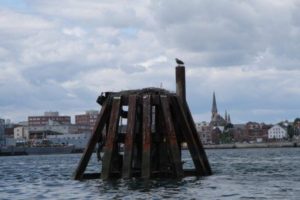
*Joe sent us an update to this post, a photo of the exact location in Maine where the osprey was born. Photo courtesy of Lauren Gilpatrick at the Biodiversity Research Institute, Portland Maine.
See, http://www.conservewildlifenj.org/education/ospreycam/ for more details about NJ osprey project and live osprey cam.
Special thanks to Robert Somes, Kathy Clark and Ben Wurst for their enthusiastic help and support.
Robert Somes, Senior Zoologist
NJ Division of Fish and Wildlife
Endangered and Nongame Species Program
Kathy Clark,CWB,
NJ Division of Fish and Wildlife
Endangered and Nongame Species Program,
Ben Wurst, Habitat Program Manager
New Jersey Osprey Project
Author Joe Mish has been running wild in New Jersey since childhood when he found ways to escape his mother’s watchful eyes. He continues to trek the swamps, rivers and thickets seeking to share, with the residents and visitors, all of the state’s natural beauty hidden within full view. To read more of his writing and view more of his gorgeous photographs visit Winter Bear Rising, his wordpress blog. Joe’s series “Nature on the Raritan, Hidden in Plain View” runs monthly as part of the LRWP “Voices of the Watershed” series. Writing and photos used with permission from the author.
Article and photos by Joe Mish
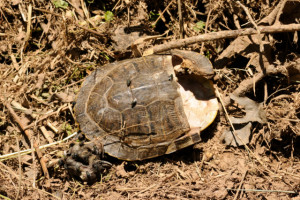
A slow journey that began more than a million years before, ended at the tip of a mower blade spinning at 3,200 rpm. This wood turtle, listed as ‘threatened’ in New Jersey, was killed in late May, while on its way to lay eggs.
May and June have been the peak of the great turtle migration where females, laden with eggs, leave the protection of quiet places to journey far and wide to dig holes and bury their eggs. Incubation takes about 70 days, more or less, and nests are left unattended.
All species, whether aquatic, terrestrial or both, like the wood turtle, seek dry land to lay eggs. Each has a preference for where and when they dig nests, though individual variation is the rule.
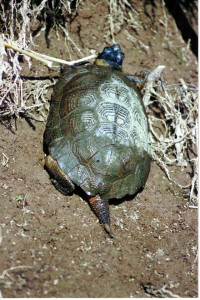
A wood turtle on its way out of the river where it hibernated to lay eggs in the gravel soil near railroad tracks.
Wood turtles prefer gravel laden soil on high ground, as found along railroad tracks, roadsides and driveways.
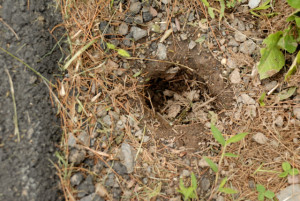
Roadways have become the killing fields for these slow moving reptiles where large blocks of undisturbed habitat are segmented by roads. A preserved island of land may be celebrated as a conservation success but the lack of linear greenways to bridge these islands is a death knell for many small creatures as it exposes them to predation and roadkill.
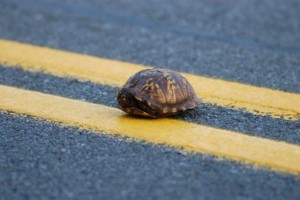
Eastern box turtle pauses mid journey across a New Jersey roadway, in a false retreat that offers no protection form speeding vehicles.
Turtles are creatures of habit and maintain consistent pathways from year to year. So that eastern box turtle you saw crossing over the double yellow line last year will be crossing the road in the same place this nesting season.
Mowing tall grass during nesting season is a more insidious cause of death for turtles and grassland nesting birds. Many farmers and landowners alter their mowing schedule to prevent killing fawns and game birds; turtles and grassland nesting birds are coincidental beneficiaries.
State conservation organizations advocate mowing early in the season and then not again until August, late July at the earliest.
A driver may possibly avoid killing a turtle on a paved road as it is somewhat visible, while a turtle in tall grass is a foregone conclusion when a mower runs through a field. The fractured shell of the wood turtle pictured, was found on a path mowed through an overgrown pasture near the South Branch.
Females may travel half a mile from wet areas to lay eggs, so please be careful. As the wood turtle is considered, “threatened “, and known to populate our area, special caution should be taken. May 29, 2015, a female wood turtle was observed digging a nest within inches of a long paved private drive, in hard packed gravel. This would be the last place you’d ever expect a turtle to dig, as you would be hard pressed with a pick and shovel to penetrate that ground. The hole was about 5 inches deep and 4 inches wide.
An awareness of turtles and their nest sites are a prerequisite to protecting them. As the eggs are laid in a small hole, covered and left unattended, you’d never know you were endangering a nest. Many eggs don’t hatch or are destroyed by predators. Then imagine an inch long hatchling trying to traverse a quarter mile through fields and open ground in an effort to reach water, bog or swamp. Survivors are few and far between.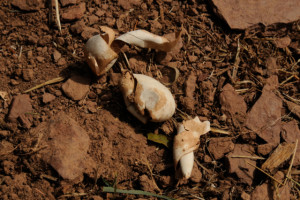
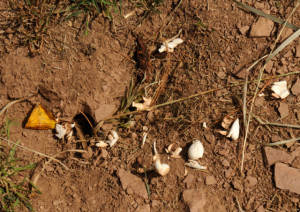
…you will find collapsed leathery egg shells scattered about; though they won’t look like egg shells. Imagine an egg shell make of cloth and inwardly collapsed to appear as a scrap of white material.
With poor odds for survival, it begs at least awareness on our part to, “first, do no harm”, and avoid destroying nests or mulching hatchlings and adults with a mower.
Turtles remain in their essential form that traces back to prehistoric times. Their evolution is an unrivaled success, even more astounding when their slow lumbering movements and low reproduction rate are considered.
Some interesting anatomical features reveal the secrets hidden behind the shell. See how the spinal cord is integral to the carapace or top shell in this painted turtle. The box turtle shell shows the spine as well as the clavicle. The thin plates that line the outer surface of the shell are attached much like a fingernail.
The easiest way to find a turtle nest is to look for the open holes in late summer and early fall. Either the nests were naturally opened by emerging turtlettes or dug out by raiding predators. In either case you will find collapsed leathery egg shells scattered about; though they won’t look like egg shells. Imagine an egg shell make of cloth and inwardly collapsed to appear as a scrap of white material. Last year I found 6 nests, one, just outside my back door. I had never seen a nest before but once I knew what to look for, they seemed to be everywhere.
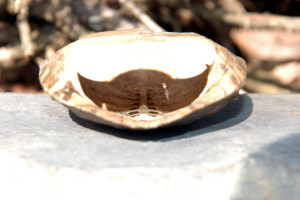
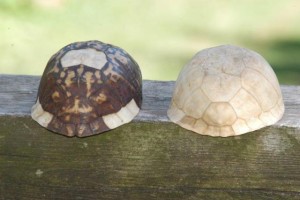
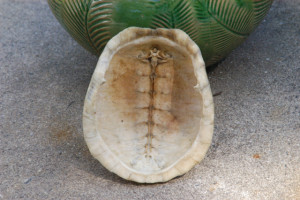
The Unami, one of the three matrilineal clans of the Lenape indians, who lived in central New Jersey, were known as the Turtle Clan. Treating the turtle with respect, keeps the clan of the turtle alive and well in the land it has known since the last glaciers receded and the land emerged from the sea. Consider, the turtle had arrived at it final evolutionary form long before humans. As new to the neighborhood, we might look to the turtle for guidance as we would a centenarian, to seek advice on how to live a long life in alignment and peace with our ever changing environment.
Author Joe Mish has been running wild in New Jersey since childhood when he found ways to escape his mother’s watchful eyes. He continues to trek the swamps, rivers and thickets seeking to share, with the residents and visitors, all of the state’s natural beauty hidden within full view. To read more of his writing and view more of his gorgeous photographs visit Winter Bear Rising, hiswordpress blog. Writing and photos used with permission from the author.
Articles and Photos by Joe Mish
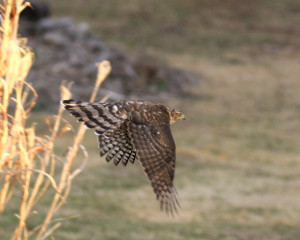
A cooper’s hawk flies off after landing in a holly tree where it jumped from branch to branch in an effort to flush a hiding songbird into the open.
Midwinter is a great time to catch a glimpse of local wildlife, especially hawks, as these large birds stand in dramatic contrast to the gray-brown leafless trees in which they perch.
The most common hawk in our region is the red-tailed hawk. Comparatively large, the adults are recognized by the bright russet colored tail. This is the only hawk whose tail is not banded or bordered by a contrasting color. The young birds have barred tail feathers, alternating russet and white, with no distinct borders.
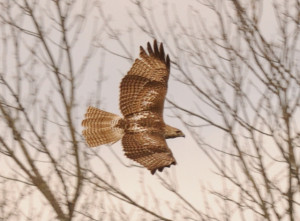
Easy to spot at highway speeds, the light breast and faded red tail stand out like a beacon when perched in trees along the roadway. Locally, I often see these hawks atop telephone poles near pastures and flood plains where they scan the open area for small mammals and ducks. Some red tails specialize in killing gray squirrels, a worthy meal for such a large bird whose energy expenditure in the winter would hardly be covered with mice or voles.
During a winter freeze when most of the river is solid ice, there are always open sections where ducks concentrate in the water and on the ice. A red tail will make an easy meal, especially of the smaller wood duck, flushing it into the air or catching it as it naps on the ice.
Last winter I watched an eagle feeding on a wood duck, speculation was the eagle took the duck from a red tail as eagles are notorious for stealing game from ospreys and hawks.
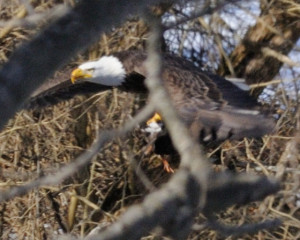
Muskrats are also high on the midwinter menu as the males often travel during the day over ice and snow as they seek food and females to breed.
A hawk requires a large nest and now is the time to scan the treetops and high tension towers for these stick built structures. One local hawk has adapted to a giant oak in someone’s backyard bordering a cluster of recently constructed homes. I have seen several local nests situated high in sycamore trees along the river. Hawk nests are relatively flat and large, not to be confused with squirrel nests which are numerous and quite round, generally built at a lower level, among thinner branches. Red tails will also use ledges as a base for their nests.
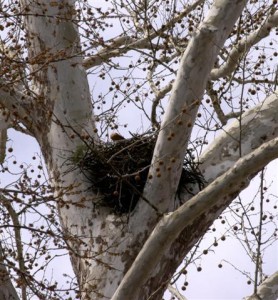
The ultimate adaptation belongs to the red tail known as, Pale Male, whose life is well documented in film, media and print as he has mated and bred several generations of hawks among the skyscrapers in mid Manhattan. His age is estimated at 24 years. Here is one site dedicated to Pale Male.
Marsh hawks share the sky with red tails and characteristically conduct ground hugging flights across overgrown fields, flood plains and grasslands and have an ability to hover in place. These hawks are slightly smaller than a red tail with dark brown coloration and a boldly banded tail. The key to identifying a marsh hawk is the bright white rump patch. These hawks are common, though not often seen and are known to migrate while red tails remain as full time residents.
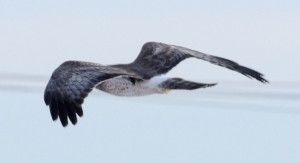
Aside from red tails, the most often seen hawks are the coopers and sharp-shinned hawks. The coopers being slightly larger than the sharp shinned. Both hawks feed on songbirds and small rodents. As each is similarly marked, identification is always controversial. More often than not, someone will submit a photo of a hawk to a website asking if it is a coopers or sharp-shinned and the replies are often split, each summarizing why they made their choice. I see the larger coopers preferring doves and rabbits while the sharp shinned has left piles of bluebird, indigo bunting and flicker feathers about the yard.
Lastly, look for the diminutive sparrow hawk, now known as the kestrel, typically perched on telephone poles and wires along open fields. This bird is about the size of a large dove, feeds on insects and small rodents. Kestrels are known for hovering before they dive on their prey and this stationary flight is a good identifying characteristic. The males are brilliantly marked with blue, shades of russet, black and white. At first glance a perched kestrel will appear as a songbird so be sure to give a second look. They are considered threatened in New Jersey and a nest box program and monitoring effort is having a positive effect on their recovery. The birds are easily baited and trapped for tagging and data collection.
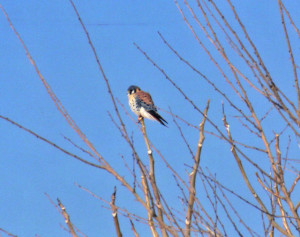
This is the winter of the hawk and hardly a commute is possible without being evaluated by a feathered predator. They can see you, can you see them?
Author Joe Mish has been running wild in New Jersey since childhood when he found ways to escape his mother’s watchful eyes. He continues to trek the swamps, rivers and thickets seeking to share, with the residents and visitors, all of the state’s natural beauty hidden within full view. To read more of his writing and view more of his gorgeous photographs visit Winter Bear Rising, his wordpress blog. Writing and photos used with permission from the author.











































